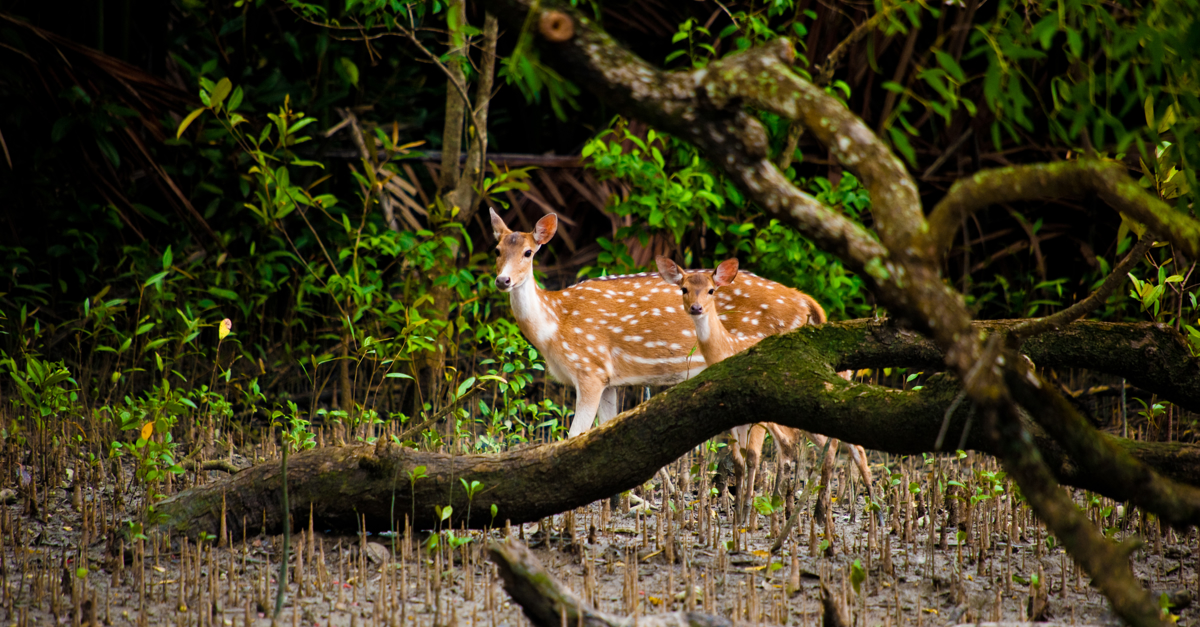
Located at the interface of land and sea, mangroves are highly resilient ecosystems that have extensive positive impacts on local ecology, socio-economic dynamics, and global climate challenges. Whereas these forests once covered more than 200,000 km2 of coastal lands, they are now at risk of disappearing entirely within the next 100 years. The Sundarbans – one of the largest of such forests – is undergoing extensive degradation of ecosystem health and fragmentation of its landscape, which results in mangrove area decline, water and soil salinization and loss in flora and fauna. Their natural resilience is faced with exceptional challenges that leave their survival hanging in the balance.
Underlying these changes to the mangrove biome are climate and human-driven activities. Tropical storms and cyclones – historically regarded as the greatest threat to the Sundarbans – have become more frequent with rising sea levels and higher ocean surface temperatures. Although mangroves are lauded for their ability to provide a buffer against wave action, lessen the extent of flooding, and even prevent loss of human life, they are incurring greater and greater damages. A recent study using satellite imagery analysis showed a decline in the resiliency and recovery rates of mangroves following severe hurricane seasons.
In addition to natural phenomena, the overexploitation of mangrove timber, industrial pollution, and the clearing of mangroves for aquaculture have contributed towards the degradation of this critical ecosystem.
This decline has extensive implications. Since mangrove forests can store up to 4 times the amount of carbon as tropical forests – amongst the highest capacity of all blue carbon ecosystems – deforestation presents a significant risk to reducing and managing carbon emissions. Under a business-as-usual scenario – where nothing is done to mitigate this risk – one study predicts that global emissions from mangrove loss could reach 2,391 Tg CO2 by the end of the 21st century – the equivalent of 515,186,935 gasoline-powered passenger vehicles driven for one year.
And the negative effects don’t stop there - where mangroves are removed to accommodate the rapidly expanding aquaculture industry, the threat to biodiversity becomes profound. Shrimp farms – which are linked to as much as 38% of global mangrove deforestation – require large amounts of water and are consequently found alongside rivers and estuaries.
During the conversion of wetlands to shrimp farms, seawater is diverted inland to supply their ponds. This disturbs the balance between freshwater and seawater, to the point that tensions between rice and shrimp farmers have grown considerably over the years. In the village of Harinkhola in Polder 22, Bangladesh, resistance to the expansion of the aquaculture industry was so acute that it led to the death of Korunamoyee Sardar – a local protestor who remains a symbol of the struggle for indigenous rights.
After long-term application of these extractive farming practices, the productivity of shrimp ponds start to decline. Efforts to counter this trend include introducing chemicals, growth hormones and even antibiotics, which has raised concerns regarding antibiotic resistance and human food safety. But while these methods may contribute towards improved productivity for a short time, the effect is temporary and aquafarmers are still faced with a limited lifetime for their shrimp ponds.
As a result, pond abandonment is frequently observed in areas where disease and pollution have occurred in shrimp cultures. This leads to a loss of employment in rural localities and a devastated landscape that homes neither mangroves nor shrimp. Scientists studying marine ecosystems in Thailand have also documented that when ponds are no longer being flooded, the risk of the loss of stored carbon is accelerated due to the erosion of soil organic matter.
Beyond these concerns, the impact of climate change has significant implications for managing mangrove ecosystems and the livelihoods of local communities, many of whom are among the poorest and most vulnerable in South Asia.
In the south of Bengal, the Bangladesh Environment and Development Society (BEDS) has adopted a community-led approach to restoring mangroves. They work alongside local people to develop appropriate disaster and risk management protocols that protect both nature and communities. In addition to providing training and education on ecosystem management, BEDS equip locals with the resources to be able to grow their own mangrove nurseries self-sufficiently.
Dare has partnered with BEDS to reforest 5000 mangroves in the Bangladeshi Sundarbans. We look forward to seeing this partnership evolve and witnessing the impact that it has on the local community. Stay updated with the latest news on our partnership by signing up to our mailing list below.

